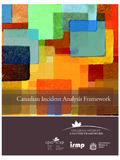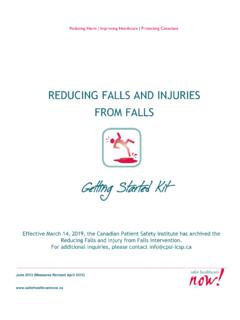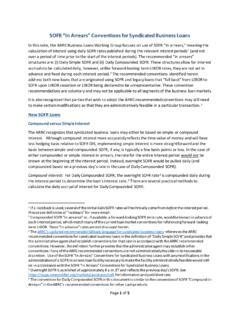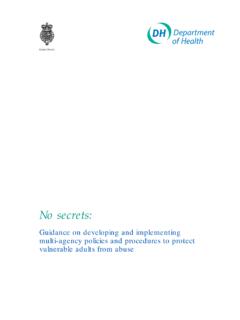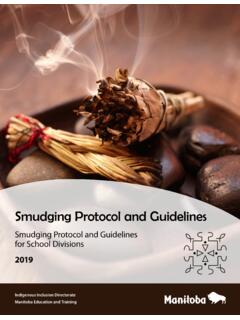Transcription of A MEDICATION SAFETY ACTION PLAN
1 A MEDICATION SAFETY ACTION PLANP roduced September 2014A MEDICATION SAFETY ACTION PLANWe are not, as a country, doing enough to ensure the safe use of medications. Medicine, in all its forms, is the most common treatment in health care and it works miracles every day when it s used appropriately. But when, as too often happens, a MEDICATION error is made, or a patient has a bad reaction to a treatment, the consequences can be terrible for individuals, their families and the health system. In Toronto in June of 2014, 37 health-care leaders met at a national summit to talk about improving MEDICATION SAFETY in Canada. The meeting began with Fervid s story, told by her daughter-in-law Johanna Trimble. It was a compelling reminder of the impact that medications can have and a moving foundation for this important summit, co-hosted by the Canadian Patient SAFETY Institute (CPSI) and the Institute for Safe MEDICATION Practices Canada (ISMP Canada), is one of a series of meetings organized by CPSI as part of its 2013-2018 business plan to accelerate ACTION on patient SAFETY in Canada.
2 The plan is for CPSI to act as a catalyst and secretariat for improving SAFETY for patients through collaboration with other national organizations, multiple levels of government, patients, families, care providers and other stakeholders from across the country. MEDICATION SAFETY is one of the forward with Four priority areas for this joint effort; the others are surgical SAFETY , infection prevention and control, and home are everywhere in health care, and with them, there are almost limitless potential for adverse events. There is a long list of grim facts and statistics detailing drug-related problems: Baker and Norton s Canadian Adverse Events Study (2004) found drug or fluid-related events were the second most common type of adverse events in Canadian hospitals, accounting for per cent of the total. A 2008 study found that more than one in nine emergency-department visits were due to drug related adverse events, and 68 per cent of them were Close to 25 per cent of patients involved in a MEDICATION adverse event died or suffered some other catastrophic event, according to the Canadian Medical Protective Association.
3 Those details come from a scan of evidence on MEDICATION SAFETY we did to prepare for the summit. It was distributed to people who were planning to attend, who were also asked to fill out a brief survey. The survey asked what their organization thought the top three concerns or gaps were in MEDICATION SAFETY , its top three priorities for it, and what it believed patients and families would identify as their top three concerns. Finally participants were asked what key components, activities or mechanisms would be most important to you and your organization to include in the ACTION plan? Answers ranged from calls to coordinate all the activities listed in the scan, to improving MEDICATION reconciliation processes, to advancing the use of digital tools to improve MEDICATION SAFETY . At the meeting the ideas raised in the survey were talked about and voted on until five emerged as themes for discussion in the world caf . They were: Reporting, learning and sharing Evidence-informed practices Partnering with patients, families and the public Education TechnologyA world caf is a meeting model used to stimulate creative thinking in large groups.
4 At the MEDICATION SAFETY meeting, participants rotated among five world Definition: MEDICATION SAFETY is freedom from preventable harm with MEDICATION use11 ISMP Canada, 2007, available from: Zed, P. et al. Incidence, serverity and preventability of MEDICATION -related visits to the emergency depart: a prospective study, CMAJ. 2008 June 3:178(12) 1563-9.* The Government of Quebec did not participated at the MEDICATION SAFETY Summit. It is solely responsible for the planning, organization, management and evaluation of patient SAFETY in September 2014caf tables for 20 minutes at a time to discuss a total of three themes each. Here s some of what they had to say:Reporting, learning and sharing How do we create a bridge to get learnings really shared? -ParticipantCanada s systems for reporting MEDICATION - SAFETY incidents are fairly robust, but our approach to sharing and learning is passive; alerts are posted on websites or distributed to limited audiences, and few busy people have hours to sift through notices of hazards, looking for any that might be relevant to them.
5 Much discussion focused on the fact that although there are multiple systems for reporting MEDICATION incidents, there is no mechanism or program to allow people across the country to learn from adverse events. Participants agreed reporting alone does not change anything: what we need to make meaningful changes is a mechanism to share lessons and implement system changes to ensure the prevention of similar incidents. Evidence-Informed PracticesThe evidence-informed practice discussions ranged widely, but there was considerable talk about the value of developing and implementing evidence-informed guidelines for clinical practice to improve MEDICATION SAFETY . However, participants agreed identifying guidelines does not ensure safer care; providers have to be persuaded to follow them. There was discussion of making the use of best-practice guidelines a requirement for accreditation, to encourage their use, as it has other SAFETY practices, and participants identified several that could greatly improve the SAFETY of MEDICATION use.
6 One suggestion was to look at developing a strategy to make opioid use safer, which could include tools and resources already available. There were also calls to rethink MEDICATION reconciliation, by fully exposing the meaning of the concept to include what it really is communication about MEDICATION at all interfaces of care. If it were presented that way, it might resonate more with providers and consumers in all parts of the with patientsEffective partnering is going to take work from both sides of the equation, because of the historical hierarchical relationship between providers and patients and families. We need to shift professional culture one participant said, in order to change providers attitudes and make them open to really sharing information with patients and families, Greater sharing, participants said, will also require public information campaigns and support for patients and their families to challenge health-care power structures and be active partners in MEDICATION SAFETY .
7 Providers also need to be equipped and ready to have difficult conversations they might rather avoid. EducationParticipants identified two education needs. Patients need better access to plain-language resources that explain medications and MEDICATION SAFETY clearly. At the same time, it needs to be made clear to health-care providers that all members of interdisciplinary teams have roles to play in MEDICATION SAFETY , and the roles individuals can and should play must be understood by all. Technology We are finding people are interpreting legislation much more narrowly than we ever intended. -ParticipantInformation systems are essential for an integrated health system, but privacy concerns are over-emphasized and a deterrent to implementing needed information technology, some participants said. Participants called for standard requirements to ensure vendors meet the needs of Canadian health care. People also wanted to see consumer portals as a mandatory feature in all patient-information systems, to encourage people to take an active role in managing their ACTION plan: At some point you just need to do something.
8 After the world caf , another round of discussion and voting determined which items would be included in an ACTION plan for MEDICATION SAFETY . CPSI and ISMP Canada, in their roles as co-hosts, then drafted this plan, outlining short- and medium-term actions for achieving improvement in each theme. The plan includes deadlines and suggestions on who might get involved in each step; it has been circulated to all the participants for MEDICATION SAFETY ACTION PLAN3 Produced September 20144A MEDICATION SAFETY ACTION PLANGoalActionDevelop a mechanism by which MEDICATION information and learning from different data sources can be shared effectively. Develop an environmental scan followed by a white paper to identify all reporting systems that could provide MEDICATION incident data to a central access point for sharing and an advisory group to oversee the development, planning, and testing required to meet this adoption of a quality-improvement approach to implementing error- prevention strategies based on what we learn from incident a quality-improvement approach to implement prevention strategies on defined and prioritized MEDICATION SAFETY issues based on the shared REPORTING, LEARNING AND SHARINGTHEME EVIDENCE-INFORMED PRACTICESGoalActionMake opioid use safer for collaborating with the National Pain Centre on guidelines for appropriate and safe use of opioids, and create a plan to work with partners to implement and evaluate the guidelines.
9 Which should include managing chronic pain in non-cancer with the Canadian Centre on Substance Abuse to identify research-based priorities for improving opioid with academic detailing groups to improve prescribing practices for opioid September 2014 GoalActionMake opioid use safer for with the Canadian Centre on Substance Abuse to identify research-based priorities for improving opioid with academic detailing groups to improve prescribing practices for opioid communication about medications at transitions in a working group to rebrand MedRec as one component of MEDICATION SAFETY , and develop a strategy to promote rebranded products and access to pharmacy services in rural and remote and profile successful use of telehealth/telepharmacy to support access to pharmacy services to rural and remote areas of other solutions to improve access to pharmacist services in all areas of EVIDENCE-INFORMED PRACTICES continuedGoalActionImprove communication about MEDICATION among providers and patients and families at transitions of and disseminate a national MEDICATION SAFETY checklist for patients and families at transitions in PARTNERING WITH PATIENTSTHEME TECHNOLOGYGoalActionIncrease input from patients and providers in the development and use of technology to improve MEDICATION a working group to develop strategies for influencing third parties such as vendors.
10 To include patients and providers in designing MEDICATION SAFETY related September 2014 GoalActionIncrease input from patients and providers in the development and use of technology to improve MEDICATION a working group to clarify privacy legislation, to allow maximum use of technology in improving MEDICATION SAFETY without compromising for availability of integrated consumer portals so patients can access their health TECHNOLOGY continued 6 Produced September 20147 MEDICATION SAFETY SUMMIT PARTICIPATING ORGANIZATIONS Accreditation Canada Association Qu becoise des tablissements de sant et de services sociaux Atlantic Health Quality and Patient SAFETY Collaborative BC Patient SAFETY & Quality Council Canada Health Infoway Canadian Agency for Drugs and Technologies in Health Canadian Anesthesiologists Society Canadian Association of Chain Drug Stores Canadian Association of Paediatric Health Centres Canadian Association of Provincial Cancer Agencies Canadian Home Care Association Canadian Institute for Health Information Canadian Medical Association Canadian Medical Protective Association Canadian Nurses Association Canadian Patient SAFETY Institute Canadian Pharmacists Association Canadian



